Related Research Articles
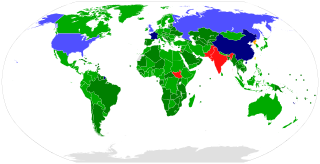
The Treaty on the Non-Proliferation of Nuclear Weapons, commonly known as the Non-Proliferation Treaty or NPT, is an international treaty whose objective is to prevent the spread of nuclear weapons and weapons technology, to promote cooperation in the peaceful uses of nuclear energy, and to further the goal of achieving nuclear disarmament and general and complete disarmament. Between 1965 and 1968, the treaty was negotiated by the Eighteen Nation Committee on Disarmament, a United Nations-sponsored organization based in Geneva, Switzerland.

Nuclear proliferation is the spread of nuclear weapons, fissionable material, and weapons-applicable nuclear technology and information to nations not recognized as "Nuclear Weapon States" by the Treaty on the Non-Proliferation of Nuclear Weapons, commonly known as the Non-Proliferation Treaty or NPT. Proliferation has been opposed by many nations with and without nuclear weapons, as governments fear that more countries with nuclear weapons will increase the possibility of nuclear warfare, de-stabilize international or regional relations, or infringe upon the national sovereignty of nation states.

North Korea has a military nuclear weapons program and, as of early 2020, is estimated to have an arsenal of approximately 30 to 40 nuclear weapons and sufficient production of fissile material for six to seven nuclear weapons per year. North Korea has also stockpiled a significant quantity of chemical and biological weapons. In 2003, North Korea withdrew from the Treaty on the Non-Proliferation of Nuclear Weapons (NPT). Since 2006, the country has been conducting a series of six nuclear tests at increasing levels of expertise, prompting the imposition of sanctions.

Relations between North Korea and the United States have been historically tense and hostile, as both countries have no diplomatic relations. The Swedish Embassy in Pyongyang is the U.S. protecting power and provides limited consular services to U.S. citizens. The DPRK has no embassy in Washington, DC, but is represented in the United States through its mission to the United Nations in New York.

The Nyongbyon Nuclear Scientific Research Center is North Korea's major nuclear facility, operating its first nuclear reactors. It is located in Nyongbyon County in North Pyongan Province, about 100 km north of Pyongyang. The center produced the fissile material for North Korea's six nuclear weapon tests from 2006 to 2017, and since 2009 is developing indigenous light water reactor nuclear power station technology.

South Korea has the raw materials and equipment to produce a nuclear weapon but has not opted to make one. In August 2004, South Korea revealed the extent of its highly secretive and sensitive nuclear research programs to the International Atomic Energy Agency (IAEA), including some experiments which were conducted without the obligatory reporting to the IAEA called for by South Korea's safeguards agreement. The failure to report was reported by the IAEA Secretariat to the IAEA Board of Governors; however, the IAEA Board of Governors decided to not make a formal finding of noncompliance. If the South created nuclear weapons it could change the balance of power on the Korean Peninsula. However, South Korea has continued on a stated policy of non-proliferation of nuclear weapons and has adopted a policy to maintain a nuclear-free Korean Peninsula.

North Korea (DPRK) has been active in developing nuclear technology since the 1950s.

In the North Korean government, the Cabinet is the administrative and executive body. The North Korean government consists of three branches: administrative, legislative, and judicial. However, they are not independent of each other, but all branches are under the exclusive political leadership of the Workers' Party of Korea (WPK).

The 2006 North Korean nuclear test was the detonation of a nuclear device conducted by North Korea on October 9, 2006.

This chronology of the North Korean nuclear program has its roots in the 1950s and begins in earnest in 1989 with the end of the Cold War and the collapse of the Soviet Union, the main economic ally of North Korea. The Chronology mainly addresses the conflict between the United States and North Korea, while including the influences of the other members of the six-party talks: China, Russia, South Korea, and Japan.
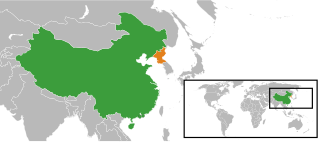
China–North Korea relations have been generally friendly, although they were sometimes strained in recent years because of North Korea's nuclear program. They have a close special relationship and China is often considered to be North Korea's closest ally. China and North Korea have a mutual aid and co-operation treaty, which is currently the only defense treaty either country has with any nation.
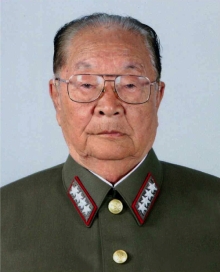
Jon Pyong-ho was a North Korean officer and politician who served as the Chief Secretary of the Korean Workers Party (KWP) Committee of the North Korean Cabinet, and director of the DPRK Cabinet Political Bureau before his retirement in 2010. Jon was described as the 'Chief architect of North Korea's nuclear programme'. Jon was a general of the Korean People's Army and a close adviser to the late Kim Jong-il.
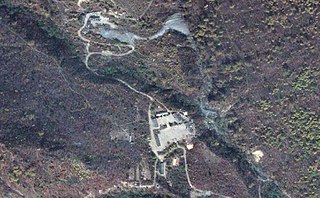
Punggye-ri Nuclear Test Site was the only known nuclear test site of North Korea. Nuclear tests were conducted at the site in October 2006, May 2009, February 2013, January 2016, September 2016, and September 2017.
38 North is a website devoted to analysis about North Korea. Its name refers to the 38th parallel north which passes through the Korean peninsula and from 1945 until the start of the Korean War in 1950 divided the peninsula into North and South Korea. Formerly a program of the US-Korea Institute at Johns Hopkins University's Paul H. Nitze School of Advanced International Studies, it is now housed at the Stimson Center and is managed by former U.S. Department of State official Joel S. Wit and Managing Editor Jenny Town. Notable contributors include nuclear scientist Sigfried Hecker, former Associated Press Pyongyang Bureau Chief Jean H. Lee, cybersecurity expert James Andrew Lewis, and North Korea Tech founder Martyn Williams.
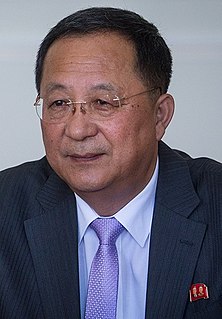
Ri Yong-ho is a North Korean politician and diplomat who served as Minister of Foreign Affairs of North Korea from 2016 to 2020.

The Democratic People's Republic of Korea conducted its sixth nuclear test on 3 September 2017, stating it had tested a thermonuclear weapon. The United States Geological Survey reported an earthquake of 6.3-magnitude not far from North Korea's Punggye-ri nuclear test site. South Korean authorities said the earthquake seemed to be artificial, consistent with an underground nuclear test. The USGS, as well as China Earthquake Networks Center, reported that the initial event was followed by a second, smaller, earthquake at the site, several minutes later, which was characterized as a collapse of the cavity formed by the initial detonation.
Hong Sung-mu is a North Korean nuclear weapons scientist and a Workers' Party of Korea (WPK) official working with North Korea's weapons of mass destruction and space programs. He is the deputy director of the party's Machine Building Industry Department (MBID) and plays a key part in the country's nuclear weapons program.
References
- ↑ "RI HONG-SOP". un.org. United Nations Security Council . Retrieved September 4, 2017.
- ↑ Jeffries, Ian (2012). North Korea, 2009-2012: A Guide to Economic and Political Developments. Routledge. p. 109. ISBN 1135116989.
- ↑ Chaim Braun; Siegfried Hecker; Chris Lawrence; Panos Papadiamantis (27 May 2016). North Korean Nuclear Facilities After the Agreed Framework (PDF). Center for International Security and Cooperation (Report). Stanford University. Retrieved 14 March 2019.
- ↑ ENERSEC Conference Series Nuclear Energy and Security (NUSEC) Book of Abstracts (PDF). IAEA. 2005. p. ix.
- 1 2 "North Korea's nuclear scientists take center stage with H-bomb test". Reuters . September 4, 2017. Retrieved September 4, 2017.
- ↑ Choe Sang-hun; Rich, Motoko; Renau, Natalie; Carlesen, Audrey (15 December 2017). "Rocket Men: The Team Building North Korea's Nuclear Missile". The New York Times. Retrieved 12 February 2019.